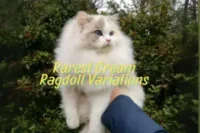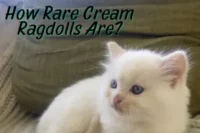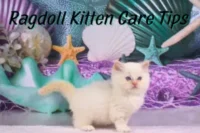The Genetics Behind Cream Ragdoll Cats Explained
Published: 4 Oct 2025
As Ragdoll cat parents, we’ve always been fascinated by the rainbow of colors these gentle fluffballs come in. From the classic seal point to the dreamy lilac, every shade feels like nature’s own brushstroke. But among them, cream Ragdoll cats hold a truly special place. Their soft, pastel coats look like a cloud dipped in peach, making them one of the most enchanting and rare variations you’ll ever meet.
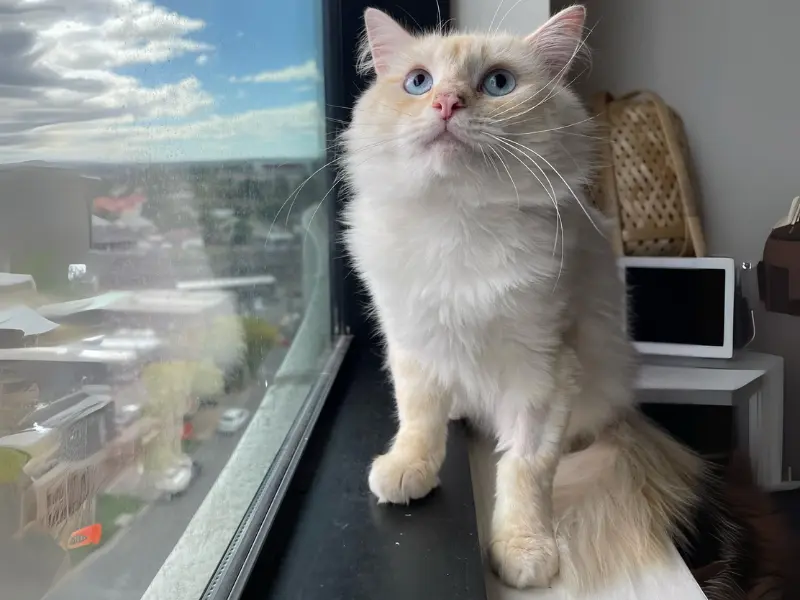
Have you ever looked at a cream Ragdoll and wondered—how does that magical coat color happen? Today, we are pulling back the curtain on the genetics behind cream Ragdolls. Don’t worry, we’ll keep it simple, playful, and full of love, just like a chat between fellow cat parents.
What Makes Cream Ragdoll Cats So Unique?
Cream Ragdolls have coats that look like vanilla ice cream swirled with just a touch of peach. Their bodies are usually light, while their “points” (ears, tail, face mask, and paws) are shaded in a pale cream or peachy tone. It’s a softer, subtler version of the flame (red) Ragdoll.
Most of us are used to seeing Ragdolls in more common colors like seal, blue, or chocolate. Cream, however, is rare because it needs a very specific genetic mix to appear. That’s part of the magic—it feels like winning the kitty lottery when a cream Ragdoll is born!
The Basics of Cat Coat Genetics (Made Simple)
Think of genes as nature’s little recipe cards. Each cat inherits a set of instructions from their mom and dad, telling their body what color their fur will be, how their eyes will look, and even whether their tail will be fluffy or sleek.
When it comes to color, genes act a lot like mixing paints. If you’ve ever blended colors as a kid, you’ll know that adding white lightens things, while adding black deepens them. Cat genetics work in a similar way.
Dominant vs. Recessive Genes
Here’s the simple scoop:
- Dominant genes are strong and show up even if only one parent carries them.
- Recessive genes are shy—they only appear if both parents pass them along.
This is why some coat colors, like seals, are common, while rare ones like cream take a little more “genetic luck.”
The Dilution Gene (The Key to Cream)
Now comes the star of our story—the dilution gene. This special gene is like a soft-focus filter on your cat’s fur. It takes bold colors and gently fades them into dreamy pastels.
- Red turns into cream.
- Black turns into blue-gray.
- Chocolate turns into lilac.
In other words, cream Ragdoll cats exist because the dilution gene works its magic on the red (flame) gene.
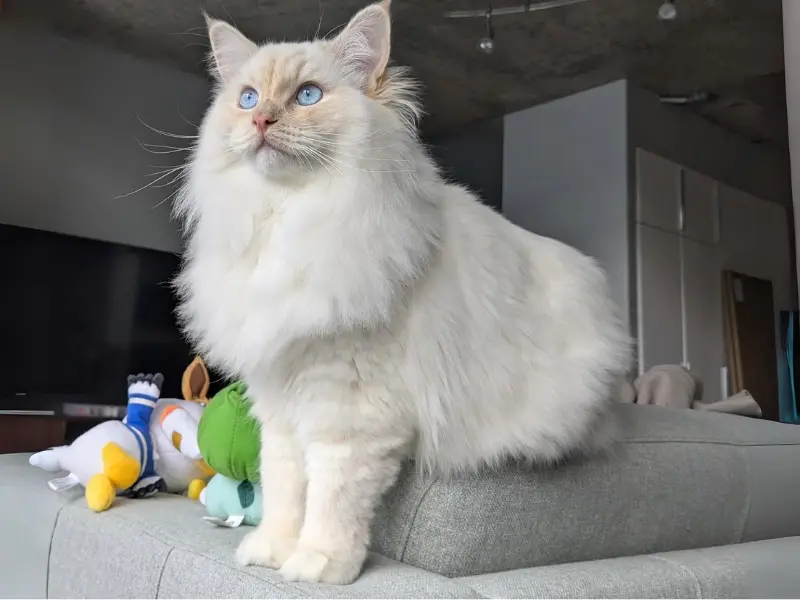
How Cream Coloring Happens in Ragdolls
Now, as I said in the start, the dilution of flame results in cream color. The magic of genes starts with O Gene.
The Role of the Red Gene (O Gene)
At the heart of every cream Ragdoll is the red gene, sometimes called the “O gene.” This gene is what creates orange or red coloring in cats. But when paired with the dilution gene, the strong fiery red gets softened into a creamy pastel shade. That’s how we end up with our lovely cream fluffballs!
Pointed Pattern + Dilution = Cream Ragdoll
Ragdolls are known for their pointed pattern, meaning their ears, face, paws, and tails are darker than their bodies. This is due to a special temperature-sensitive gene that darkens the cooler parts of their body (like the ears and tail).
In a cream Ragdoll, those points are a pale peachy-cream instead of fiery orange. The effect is subtle, elegant and oh-so dreamy.
Male vs. Female Inheritance
Here’s where it gets interesting. The red gene sits on the X chromosome:
- Males (XY) only need one red gene to show cream or flame coloring.
- Females (XX) need two red genes to appear cream or flame.
This is why cream Ragdoll boys are often easier to find than cream Ragdoll girls. Girls sometimes end up as “torties” (tortoiseshells), which mix cream or flame with other colors.
Are Cream Ragdoll Cats Rare?
Yes—they are! Compared to the classic seal or blue Ragdoll, cream Ragdolls are a bit harder to find. The reason is simple: both the red gene and the dilution gene have to line up perfectly for a cream kitten to be born. Breeders may see many seal, blue or chocolate kittens in a litter before a single cream shows up.
That’s why when we first spotted a cream kitten at a breeder’s home, we couldn’t believe our eyes. It felt like finding a little hidden treasure wrapped in fur.
Other Dilute Variations Related to Cream
The dilution gene doesn’t just create cream. It works its magic on other colors too:
Lilac Ragdoll
Chocolate turns into soft lilac, giving the cat a delicate grayish-pink tone.
Blue Ragdoll
The seal turns into blue-gray and is called Blue Ragdoll one of the most popular and stunning diluted colors.
Flame (Red) Ragdoll
The fiery red version that, when diluted, becomes cream.
Looking at these colors side by side really makes us appreciate just how unique cream is. While blue and lilac are fairly common among Ragdolls, cream still stands out as one of the rarest.
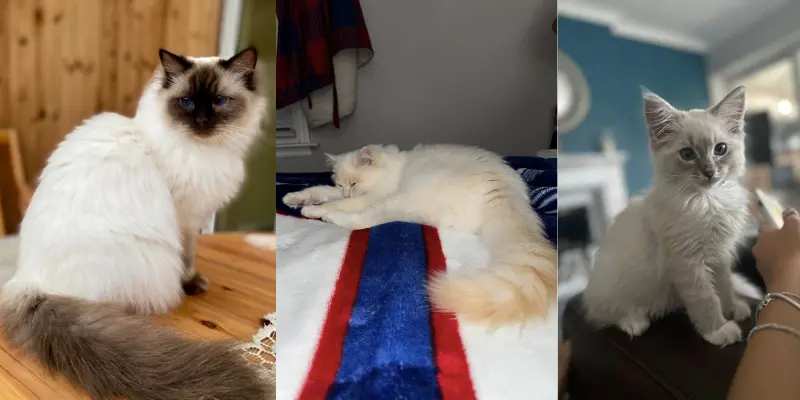
Why Understanding Genetics Matters for Cat Parents
So why should we, as Ragdoll parents, care about coat genetics? A few reasons:
- Predicting Kittens: If you’re adopting from a breeder, knowing the genetics can give you a hint about possible kitten colors.
- Appreciating Rarity: When you know how rare cream Ragdolls are, you’ll love and treasure them even more.
- Avoiding Confusion: Some cream Ragdolls get mistaken for flame or lilac, so understanding the genetics helps clear up mix-ups.
It’s like having a behind-the-scenes look at how nature paints our cats!
Price and Availability of Cream Ragdoll Cats
Because they’re rare, cream Ragdoll kittens can sometimes cost more than standard colors. The price usually depends on:
- Breeder reputation and experience
- Pedigree and show quality
- Local demand for rare colors
While cream Ragdolls aren’t always available, patience pays off. If your heart is set on one, be ready to join a waitlist or travel a little farther to meet your perfect fluffy companion.
Should You Adopt a Cream Ragdoll Cat?
Here’s the truth: whether cream, seal or blue—every Ragdoll is a sweetheart. Their personality isn’t tied to their color. Cream Ragdolls are just as affectionate, floppy, and playful as the rest.
But if you adore rare and pastel-colored kitties, cream Ragdolls will melt your heart even more. Before adopting, remember to:
- Do your homework on breeders.
- Be prepared for regular grooming (all Ragdolls need it!).
- Focus on health and temperament first, color second.
At the end of the day, color is just the cherry on top of an already purr-fect Ragdoll sundae.
Conclusion
Cream Ragdoll cats are living proof of how fascinating and beautiful genetics can be. Thanks to the red gene and the magical dilution gene, we get these pastel-colored fluffballs that brighten our homes and hearts. They may be rare but that just makes them even more special to love.
So the next time you see a cream Ragdoll, you will know the science behind their dreamy coat and maybe fall even more in love with these gentle cloud-like kitties.
FAQs about Cream Ragdoll Gene
Here are frequently asked questions:
They inherit the red gene which normally makes red/flame cats, plus the dilution gene, which softens the red into cream.
They are among the rarest! Cream and lilac are both less common than seal, blue or chocolate.
Yes, if both parents carry the red gene and the dilution gene, even if they don’t look cream themselves.
Yes. Like all Ragdolls, they’re born white and their points darken with age, turning cream or peachy as they mature.
No, coat color doesn’t affect health. Cream Ragdolls are just as healthy as other colors.
Often yes, because they’re rare and in high demand.
Cream Ragdolls have very pale peachy or pastel points, while flame Ragdolls have deeper orange or red points.

- Be Respectful
- Stay Relevant
- Stay Positive
- True Feedback
- Encourage Discussion
- Avoid Spamming
- No Fake News
- Don't Copy-Paste
- No Personal Attacks



- Be Respectful
- Stay Relevant
- Stay Positive
- True Feedback
- Encourage Discussion
- Avoid Spamming
- No Fake News
- Don't Copy-Paste
- No Personal Attacks


